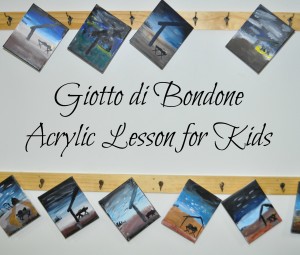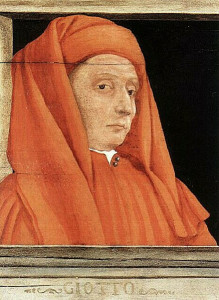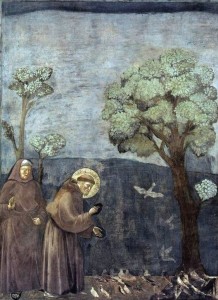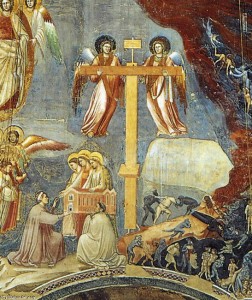 Isn’t it amazing that we can still enjoy artwork from 700 years ago?
Isn’t it amazing that we can still enjoy artwork from 700 years ago?
Giotto di Bondone
Giotto is known as the first artistic genius of the Italian Renaissance to break away from the elongated and stoic Byzantine artistic style. (Quick history recap – The fall of Rome split the empire into two parts. The western half moved into the dark ages, also known as the early medieval period, and the eastern half flourished as the Byzantine Empire. The Renaissance is immediately after the time of knights and castles at the end of the medieval period.)

Paulo Uccello
c. 1450, Tempera on wood
Musée du Louvre, Paris
Bondone means “a person of good standing,” which properly reflects Giotto’s life. Legend has it that Giotto was discovered as a young shepherd by the famous artist Cimbaue, doodling on a rock. His work was so lifelike that the master immediately invited him to apprentice. Even as an apprentice it is said he painted such a realistic fly that Cimabue tried several times to brush it off.
Di Bondone’s earliest known works, a series of frescoes (paintings on wet plaster) on the life of St. Francis in the church of Assisi, were completed in the 1290s. There he demonstrated his exceptional ability to draw human emotion accurately through his use of tighter-than-normal brush strokes.

Giotto di Bondone
fresco, 1297-99
San Francesco, Upper Church, Assisi, Italy
In order to create an appropriate sense of space, Giotto used background images that resembled stage sets. He also painted characters with their backs towards the observer making the viewer appear to have a place in the painting.

Giotto di Bondone
fresco, 1305–06
Arena Chapel, Padua, Italy

Giotto di Bondone
fresco
The Scrovegni Chapel (1305) is often called Giotto’s masterpiece. Interestingly, it was build not as a church for corporate worship, but as a private location for family worship and burial. It has been speculated that it was commissioned as a penitence for the owner having charged interest for lending money (which was considered a sin at that time). We can see possible evidence of this in the presence of the owner near the center of The Final Judgement, handing the Chapel to the Three Marys.
Bondone’s fame grew throughout his life, attracting the attention of popes and kings. In 1334, three years before his death, the city of Florence appointed him chief of public works. He was in the middle of building the Campanile (‘Giotto’s Bell Tower’) at the time of his death. He passed away wealthy, famous, and successful.
Read:

- A Boy Named Giotto by Paolo Guarnieri
- Giotto by Mike Venezia
Observe:
- Watch a slideshow of Giotto’s work
- Enjoy a short video biography of Giotto
Create:
In order to complete this project the following supplies will be needed:
- Acrylic Paint – need a minimum of blue, white and black – can be shared
- Grumbacher Filbert Brush synthetic, approx. size 8- 1 per student (if you don’t have this particular brush, just use what you have and I’m sure it will be just fine)
- 1 8×10 canvas – need 1 per student
- Prang crayons, one 8 color set – need: 1 set per student
- 1 glue stick – can be shared
- 1 water container – need 1 per student
- everyday pencil with an eraser
- paint pallet (you don’t need a fancy pallet. A paper plate or piece of cardboard would do)
- smock
- Paper towels
Consider:
Giotto frescoes are found only in places of worship. Of course, his times may have had an impact on that decision, but it gives us something to consider today. In 1Cor. 10:31 we learn,
“So whether you eat or drink or whatever you do, do it all for the glory of God.“
If you have time, feel free to read what Biblical scholars think.
What do you think “all” means in this verse? Should we only paint for the church?


Pingback: Leonardo da Vinci Graphite Lesson for kids - Liberty Hill House